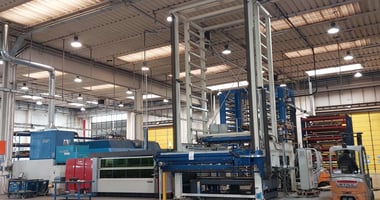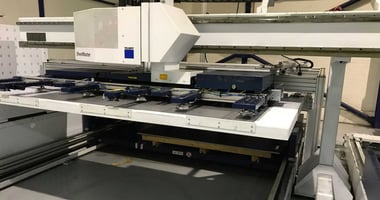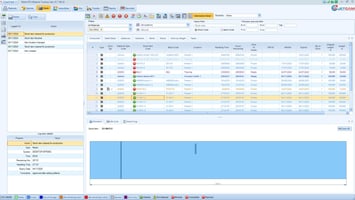In the ever-evolving landscape of manufacturing technology, efficiency and cost reduction are at...
The Different Types of Data Passed Back from Nesting Software to ERP
Discover the various types of data that can be transmitted from nesting software to ERP systems, their significance, and the advantages of electronic transmission over manual methods.
Types of data transmitted from nesting software to ERP
When it comes to transmitting data from nesting software to an Enterprise Resource Planning (ERP) system, there are two key types of information that can be passed back:
- Material Costing Data: Nesting software can accurately calculate how much material uses as a percentage of the overall sheet, even taking scrap into consideration.
- Manufacturing Data: Nesting software can also provide information such an estimation of how long the nest will take to cut, again apportioning the time (and therefore cost) against each part..
By transmitting these types of data from nesting software to ERP, companies can enhance their operational efficiency, reduce manual errors, and improve overall productivity.
The importance of transmitting data from nesting software to ERP
Transmitting data from nesting software to an ERP system is crucial for a number of reasons:
- Accurate Material Stock Management: By transmitting the material consumed back to the ERP system, companies can ensure that their inventory levels are always up to date. This helps prevent stockouts and minimises production delays.
- Streamlined Production Process: When work orders are transmitted from nesting software to ERP, it allows for better planning and coordination of production activities. This helps minimise bottlenecks and optimise resource allocation.
- Visibility: By transmitting machine data to ERP, manufacturers gain real-time visibility into machine utilisation and performance. This enables proactive maintenance and helps prevent unexpected downtime. This type of data can be captured in one of two ways - either by the operator logging start/stop times or by using machine monitoring systems.
Overall, transmitting data from nesting software to ERP allows for better decision-making, improved resource allocation, and enhanced operational efficiency.
Benefits of electronic transmission over manual methods
While manual methods of transmitting data from nesting software to ERP were once common, electronic transmission offers numerous benefits:
- Time and Cost Savings: Electronic transmission eliminates the need for manual data entry, reducing the time and effort required to transfer information. This saves costs associated with manual labour.
- Real-time Updates: Electronic transmission allows for real-time updates, ensuring that the ERP system always has the latest information. This enables better decision-making and improves overall visibility into operations.
- Seamless Integration: Electronic transmission enables seamless integration between nesting software and ERP systems. This means that data flows smoothly between the two systems, eliminating the need for manual intervention.
- Data Accuracy: Electronic transmission reduces the risk of manual errors that can occur during data entry. This ensures that the data transferred is accurate and reliable, leading to improved decision-making.
By leveraging electronic transmission methods, businesses can streamline their data transfer processes, improve data accuracy, and achieve significant time and cost savings.
Different ways to electronically send data from nesting software to ERP
There are several ways to electronically send data from nesting software to ERP systems:
- API Integration: Application Programming Interface (API) integration allows for direct communication between the nesting software and the ERP system. This enables seamless data transfer and real-time updates.
- File Transfer: Data can be exported from the nesting software and transferred to the ERP system using file transfer across the local area network. This is often the quickest and most cost-effective to set up, as most systems allow for easy import/export of data, however it may not be completely automated, depending on the system.
- Web Services: Web services provide a standardised way for different software applications to communicate with each other over the internet. Nesting software can utilise web services to transmit data to the ERP system.
- Cloud-based Integration: With cloud-based integration, data is stored and accessed in the cloud. Nesting software and ERP systems can be integrated through cloud-based platforms, allowing for easy and secure data transfer.
These different methods of electronic transmission provide flexibility and options for organisations to choose the most suitable approach based on their specific requirements and existing IT infrastructure. Note that it is generally more cost-effective to make changes on the nesting software side rather than ERP, as many ERP systems are bespoke and require costly development for even the smallest changes. For example, use JETCAM Orders Controller or CrossTrack to make data available either by (manual or automatically generated) CSV output, or using Web Services.
Conclusion
Understanding the different types of data that can be transmitted from nesting software to ERP is essential for organisations looking to optimise their operations. By transmitting data such as material consumption, scrap and machining data, companies can enhance inventory management (including tracking of remnants and waste), streamline production processes, and gain real-time visibility into machine utilisation.
Electronic transmission offers significant advantages over manual methods, including time and cost savings, real-time updates, seamless integration, and improved data accuracy. Organisations can choose from various electronic transmission methods such as API integration, file transfer, web services, and cloud-based integration.
By embracing electronic transmission and leveraging the right methods, organisations can unlock the full potential of their nesting software and ERP systems, leading to improved efficiency, productivity, and competitiveness.
%20(Custom).jpg?width=1000&height=252&name=JETCAM%20logo%20(glossy%20effect)%20(Custom).jpg)



